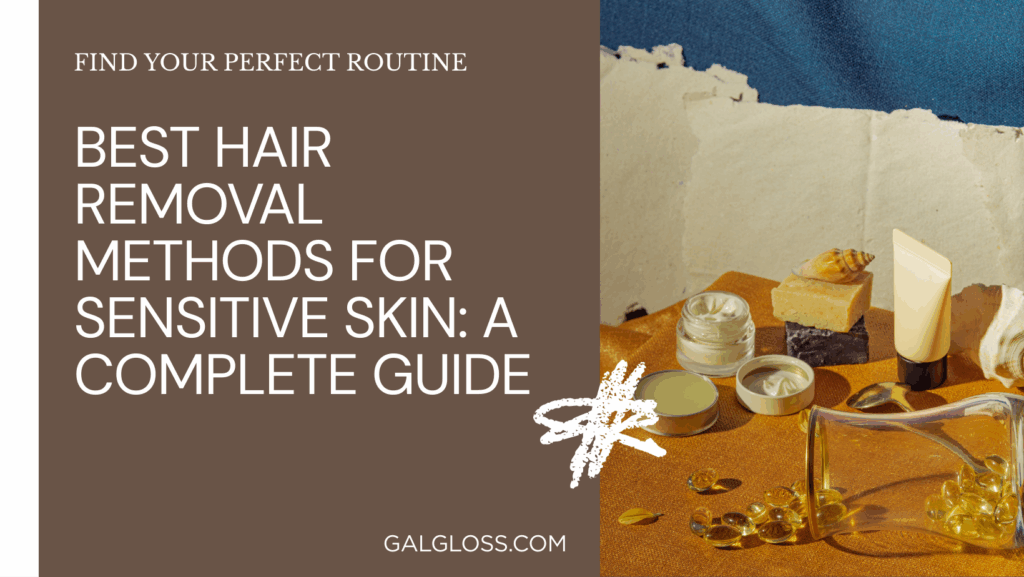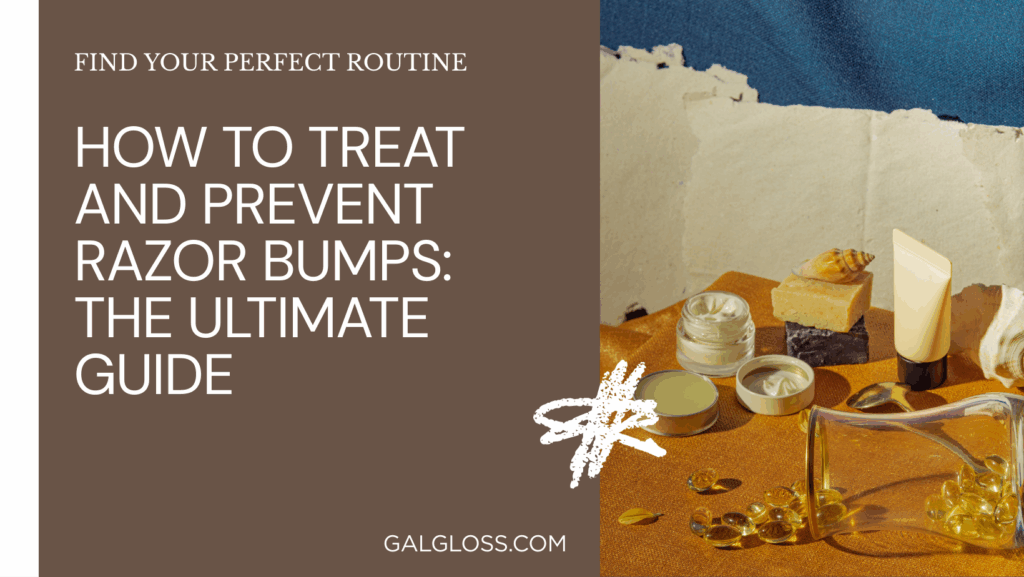Ever felt like you’re caught between a rock and a hard place when it comes to hair removal? If you’ve got sensitive skin, you’re not alone. It’s like trying to walk a tightrope – you want smooth, hair-free skin, but one wrong move and you’re dealing with angry red bumps, itching, or worse.
But don’t throw in the towel just yet! There’s hope for even the most delicate skin types. In this guide, we’ll explore the best hair removal methods for sensitive skin, helping you navigate the tricky waters of achieving silky smoothness without the irritation.
Understanding Sensitive Skin

Before we dive into hair removal techniques, let’s talk about what makes skin sensitive. Think of sensitive skin as the drama queen of the dermis world – it reacts to just about anything. Common triggers include:
- Harsh chemicals
- Fragrances
- Temperature changes
- Certain fabrics
- Even stress!
If your skin turns red, itchy, or bumpy at the drop of a hat, you’re probably dealing with sensitive skin. It’s like having a built-in alarm system that goes off a little too easily.
Top Hair Removal Methods for Sensitive Skin
Now, let’s break down the most popular hair removal methods and see how they stack up for sensitive skin:
1. Waxing: The Pull-and-Pray Method
Pros:
- Long-lasting results (3-4 weeks)
- Can lead to finer regrowth over time
Cons:
- Ouch factor is high
- Risk of irritation and ingrown hairs
Best practices for sensitive skin:
- Choose a hypoallergenic, low-temperature wax
- Always do a patch test first
- Apply a soothing, alcohol-free lotion afterward
Waxing’s like ripping off a Band-Aid – quick but painful. For sensitive skin, it’s a bit of a gamble. If you’re brave enough to try, go to a pro who knows how to handle delicate skin.
2. Shaving: The Old Reliable
Pros:
- Quick and easy
- Painless (when done right)
Cons:
- Short-lived results
- Can cause razor burn and ingrown hairs
Tips for minimizing irritation:
- Use a sharp, clean razor (single-blade for extra sensitive skin)
- Shave in the direction of hair growth
- Apply a fragrance-free shaving cream or gel
Shaving’s like mowing the lawn – it gets the job done, but you’ll be back at it before you know it. For sensitive skin, it’s all about technique and using the right products.
3. Depilatory Creams: The Chemical Approach
Pros:
- Painless
- Easy to use at home
Cons:
- Strong odor
- Can cause chemical burns if left on too long
Precautions for sensitive skin:
- Always do a patch test 24 hours before use
- Choose formulas specifically for sensitive skin
- Don’t exceed the recommended time limit
Depilatory creams are like magic potions – they dissolve hair away. But for sensitive skin, they can be more trick than treat. If you go this route, be extra cautious and follow instructions to a T.
4. Epilators: The Electric Solution
Pros:
- Long-lasting results
- Can lead to finer regrowth over time
Cons:
- Can be painful
- May cause redness and bumps
Tips for comfortable use:
- Start with the lowest speed setting
- Use on slightly damp skin to reduce friction
- Apply a cooling gel afterward
Using an epilator is like plucking multiple hairs at once. It’s not for the faint of heart, but some find it gentler on sensitive skin than waxing.
5. Laser Hair Removal: The High-Tech Option
Pros:
- Long-term reduction in hair growth
- Can be gentler on skin over time
Cons:
- Expensive
- Requires multiple sessions
Is it suitable for all skin types?
- Works best on light skin with dark hair
- Newer technologies are making it safer for darker skin tones
Laser hair removal is like sending your hair to boot camp – it weakens the follicles over time. For sensitive skin, it can actually be a good long-term solution, reducing the need for frequent hair removal.
6. Electrolysis: The Permanent Solution
Pros:
- Permanent hair removal
- Suitable for all hair colors and skin types
Cons:
- Time-consuming
- Can be painful
Considerations for sensitive skin:
- Start with small areas to test your skin’s reaction
- Choose a skilled practitioner experienced with sensitive skin
- Expect some redness and swelling initially
Electrolysis is like weeding a garden one plant at a time – it’s thorough but takes patience. For those with sensitive skin willing to endure some discomfort for permanent results, it’s worth considering.
7. Threading: The Ancient Technique
Pros:
- Precise and great for facial hair
- No chemicals involved
Cons:
- Can be painful
- Limited to small areas
Pros and cons:
- Gentle on skin if done correctly
- Risk of irritation if the thread isn’t clean
Threading’s like plucking with dental floss – it’s an art form. For sensitive facial skin, it can be a good alternative to waxing or plucking, but find an experienced practitioner.
Natural and DIY Hair Removal Methods
For those who prefer to keep things au naturel, here are some gentle options:
Sugar Waxing
Mix sugar, lemon juice, and water to create a sticky paste. It’s like making candy, but for your skin! This method is gentler than traditional waxing and uses ingredients you can pronounce.
Turmeric Paste
Combine turmeric powder with milk or water. It’s like painting yourself yellow, but it can help soften and remove hair over time. Bonus: turmeric has anti-inflammatory properties.
Pumice Stone Technique
Gently rub a wet pumice stone over areas with fine hair. It’s like giving yourself a mini-exfoliation while removing hair. Be extra gentle and use lots of water to reduce friction.
Prepping Sensitive Skin for Hair Removal
Preparation is key for sensitive skin. Here’s how to set the stage for success:
- Exfoliate gently: Use a soft washcloth or mild scrub to remove dead skin cells. It’s like sweeping the floor before mopping – it helps prevent ingrown hairs.
- Moisturize: Keep skin hydrated with fragrance-free lotion. Think of it as giving your skin a drink of water.
- Patch test: Always test new products on a small area first. It’s like dipping your toe in the water before jumping in.
Aftercare for Sensitive Skin
Post-hair removal care is crucial. Here’s how to soothe your skin:
- Look for products with aloe vera, chamomile, or calendula
- Avoid hot showers, tight clothing, and scented products for 24 hours
- Apply a cool compress if you experience redness or swelling
It’s like putting out small fires – addressing irritation quickly can prevent it from spreading.
Choosing the Right Method for You
Selecting the best hair removal method is like picking the right tool for a job. Consider:
- Your pain tolerance (waxing vs. shaving)
- Budget (professional treatments vs. at-home methods)
- Time commitment (quick daily shaving vs. longer-lasting laser treatments)
- Skin sensitivity level (patch test different methods)
Remember, you might need to combine methods for different body areas. What works for your legs might not be best for your face.
When to See a Dermatologist
Sometimes, you need to call in the pros. See a dermatologist if you experience:
- Severe irritation or rashes that don’t go away
- Persistent ingrown hairs
- Allergic reactions to hair removal products
It’s like going to a mechanic when your car makes a weird noise – sometimes you need expert help.
Conclusion
Finding the best hair removal method for sensitive skin is like solving a puzzle – it takes some trial and error, but the right pieces are out there. Whether you opt for the quick and easy route of shaving, the long-term investment of laser hair removal, or the natural approach of sugar waxing, there’s a method out there that can work for your sensitive skin.
Remember, what works for your friend might not work for you. Be patient with your skin, listen to its reactions, and don’t be afraid to mix and match methods for different areas of your body. With the right approach and a bit of TLC, you can achieve smooth, hair-free skin without setting off your skin’s alarm bells.
So go forth and experiment (carefully)! Your perfect hair removal solution is out there, waiting to be discovered. And hey, if all else fails, embrace the fuzz – it’s all natural, after all!





